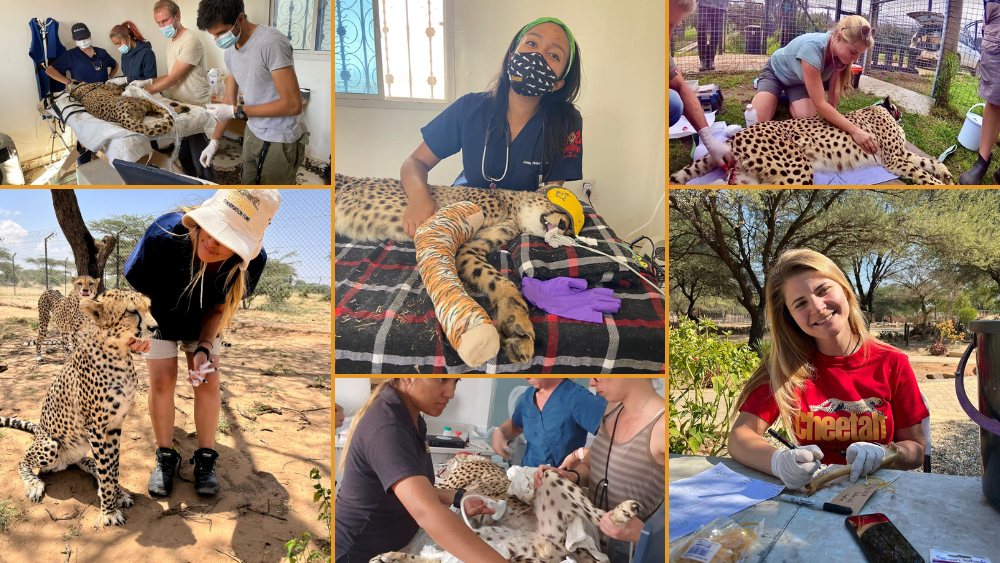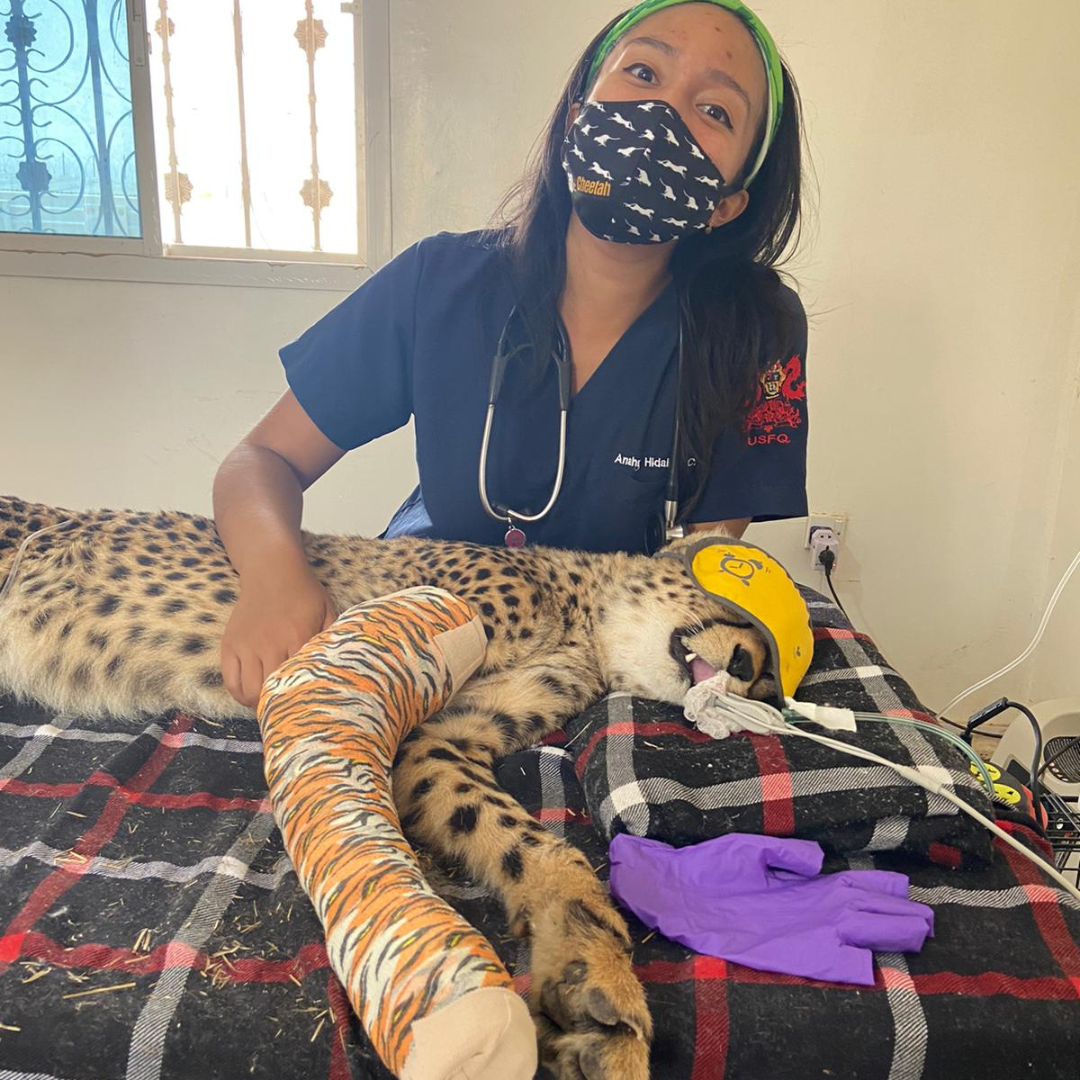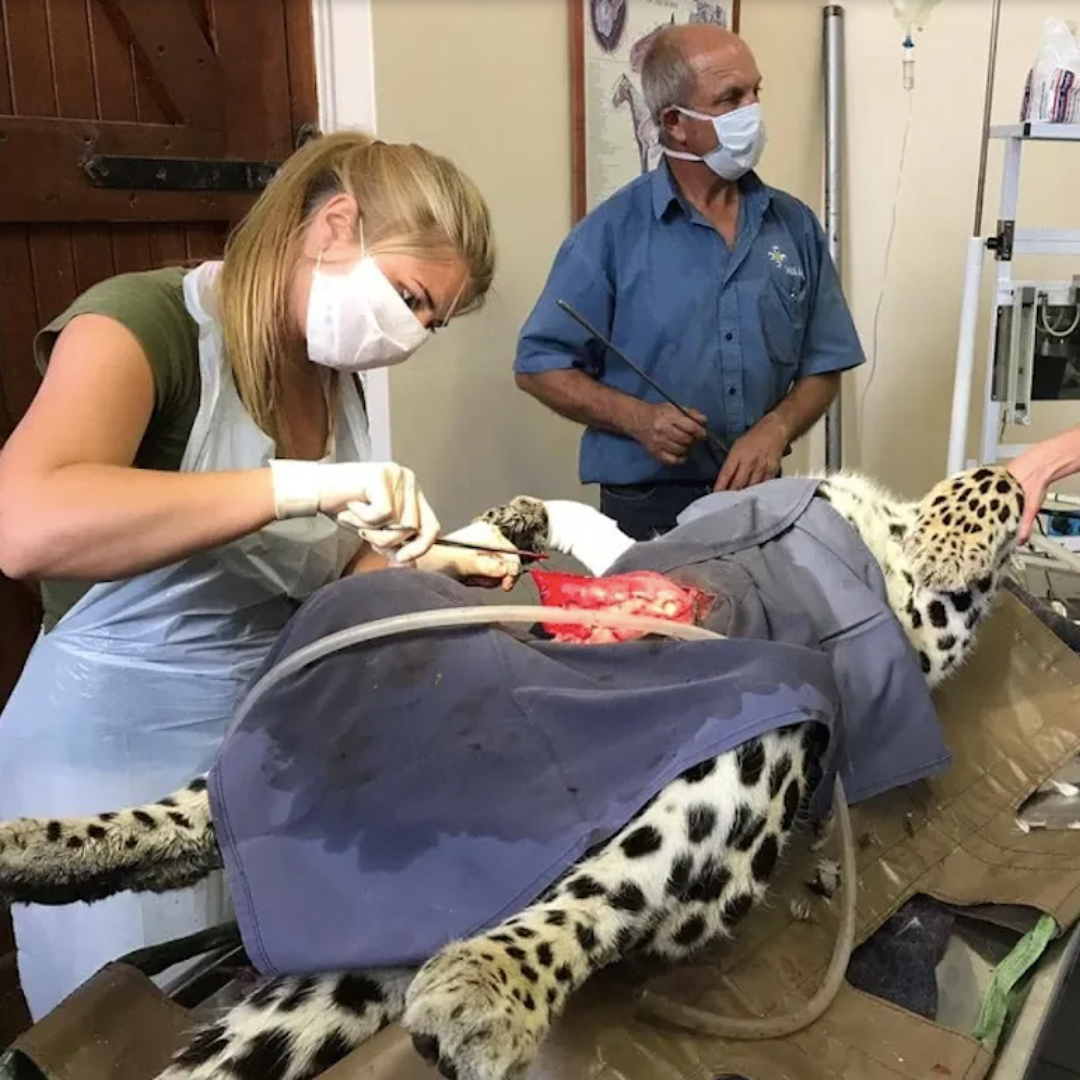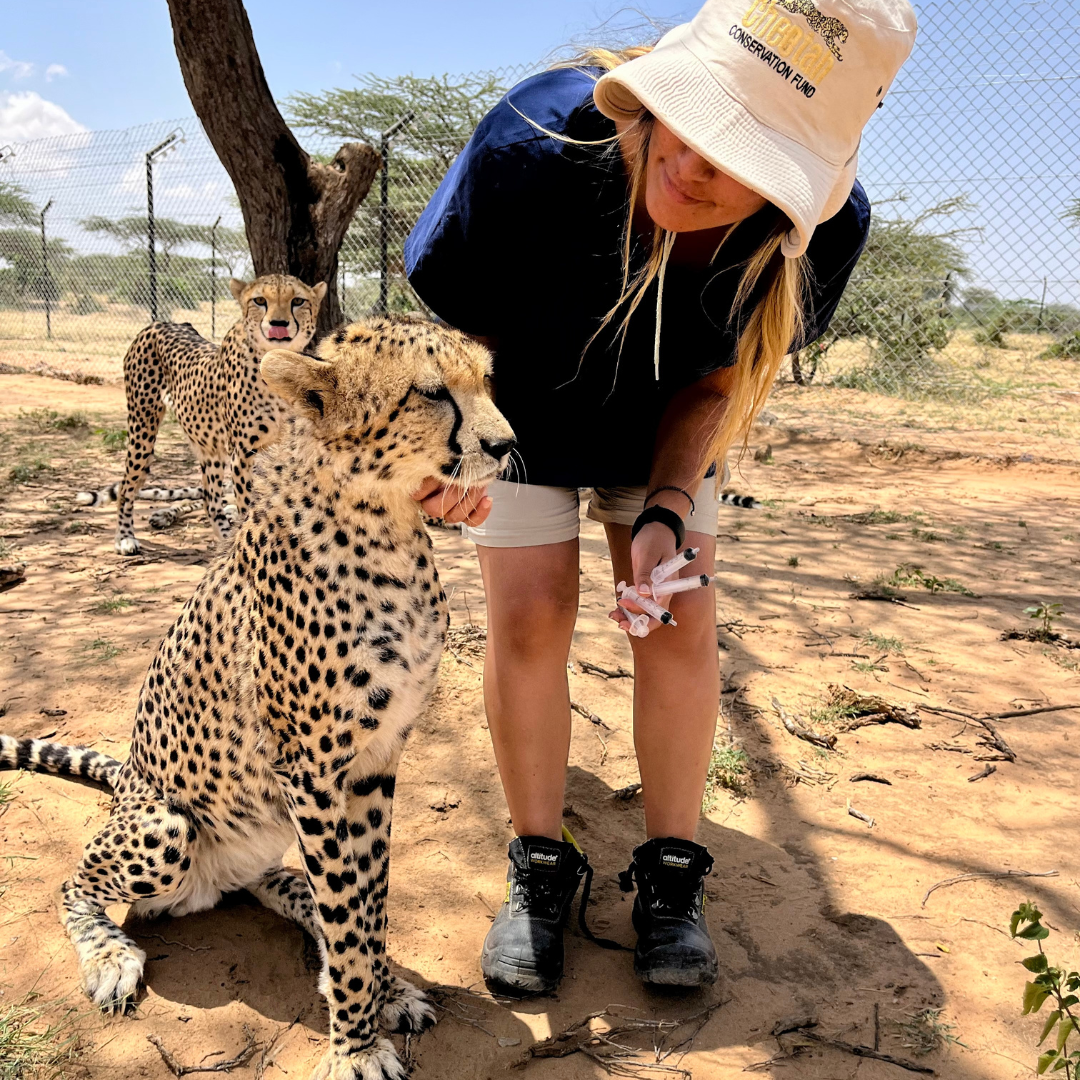World Veterinary Day: The Inspiring Journeys of CCF’s Wildlife Veterinarians
-

- by Zila Oliveira April 26, 2024

This post was broadcasted from Cheetah Conservation Fund United Kingdom.
Today marks a significant occasion for us at the Cheetah Conservation Fund UK (CCF UK): The World Veterinary Day. It’s a time for us to acknowledge the pivotal role of veterinarians in the care and conservation of diverse species, including the majestic cheetah. Within CCF, veterinarians play a crucial role, diligently tending to the needs of cheetahs, ensuring their well-being and resilience, particularly for vulnerable cubs affected by the illegal wildlife trade.
This year, we aim to spotlight the contributions of female veterinarians who tirelessly champion the cause of wildlife preservation, including the protection of cheetahs. In the United Kingdom, 60% of registered veterinarians with The Royal College of Veterinary Surgeons (RCVS) are women, a figure that climbs to 88% in the United States Consequently, many of these women in the veterinary profession from different parts of the world channel their expertise towards wildlife conservation.
Numerous veterinarians such as Anahi Hidalgo and Catherine Hauw at CCF exemplify this commitment. United by a lifelong passion for wildlife, they now devote their careers to caring for animals across Africa, spanning regions like Namibia, Somaliland, and Kenya. We’ve interviewed them to shed light on their experiences, delving into the challenges and rewards of being wildlife veterinarians.

Embarking on Anahi and Catherine’s journey from the start
Embarking on a journey that spans continents and cultures, Anahi Hidalgo and Catherine Hauw traverse landscapes both enchanting and formidable in their shared mission to safeguard wildlife. Though hailing from diverse backgrounds, their passion for wildlife started from a very young age.
For Catherine, the fascination with wildlife traces back to childhood days spent entranced by “The Lion King,” and her passion for wildlife hasn’t waned since then. “At 18, I ventured to South Africa to volunteer at a wildlife orphanage, where my connection with the country and its wildlife deepened. It was a defining moment, solidifying my resolve to work with big cats.”
Their paths converged through a shared determination to make a difference in the world of conservation. Catherine’s journey, a tapestry woven with academic pursuits and hands-on experiences, led her from the halls of academia to the wilds of South Africa. “After studying biology in Montreal, I embarked on a veterinary journey that took me across continents,” she recounts. “Volunteering at wildlife sanctuaries in Thailand, India, and Australia honed my skills, but it was in South Africa where I found my true calling. The decision to specialise in wild animal health was driven by an unwavering commitment to protect these creatures.”

Anahi’s journey began in Ecuador, where her passion for wildlife found expression in the halls of a veterinary school. “As a student, I immersed myself in the world of wildlife, volunteering at the Veterinary Wildlife Hospital,” she recalls fondly. “International internships in Colombia and the USA further fuelled my passion, exposing me to a diverse array of species—from big felines to eagles and more.” Her journey unfolded across continents, from the Galápagos Islands to the rugged landscapes of Somaliland, where she found herself drawn to the cause of cheetah conservation with CCF.
Their paths intersected in the heart of Africa, where they now stand shoulder to shoulder, united in their commitment to protect and preserve the majestic creatures that roam its plains. For Anahi and Catherine, the journey is far from over—it’s a testament to the enduring power of passion and purpose in the pursuit of a shared dream.

Their work at CCF
Catherine’s journey with CCF began in August 2023, marking the inception of a collaboration that would shape her academic pursuits. “I joined forces with CCF for my Master’s research project,” she recounts. “I was astounded by Laurie Marker’s foresight—the meticulous curation of a bone bank dating back to 1991 proved invaluable for my investigations into lead levels in carnivores. Working amidst cheetahs and alongside a world-class genetics lab made my time at CCF truly unforgettable.”

Catherine working at CCF
Anahi’s involvement with CCF was multifaceted, as she delved into the organisation’s diverse initiatives in Somaliland and Namibia. Reflecting on her experiences, she sheds light on the nuanced challenges faced by conservationists in each region. “In Namibia, the spectre of human-wildlife conflict looms large,” she explains. “The Anatolian Shepherd dog program plays a pivotal role in mitigating this conflict and safeguarding cheetah populations from retaliatory measures. Meanwhile, in Somaliland, community engagement is paramount in combating illegal wildlife trade, given the prevalence of smuggling routes in the area.”
Her tenure with CCF was punctuated by moments of profound significance, none more so than her involvement in the rescue and rehabilitation of cheetah cubs. “It was an experience that left an indelible mark on my soul,” she reminisces. “Caring for ‘The Elements,’ as we affectionately named them, tested the limits of our resolve. Pacha, the smallest of the litter, arrived in dire straits—severely dehydrated and malnourished. Through tireless dedication and countless sleepless nights, we nursed her back to health. Today, at 2.5 years old, she stands as a testament to the resilience of these magnificent creatures.”

Anahi working at CCF
Cheetah conservation and health in their vision
With years of experience working closely with big cats, Anahi and Catherine have gained first-hand insight into the myriad challenges facing cheetah conservation, particularly concerning health. Cheetahs, they explain, confront a unique set of health hurdles, often stemming from their genetic composition and environmental factors.
“Compared to other big cats, cheetahs exhibit distinct health vulnerabilities,” Catherine observes. “Historically low genetic diversity due to population declines renders them more susceptible to various ailments. Conditions such as gastritis, kidney diseases, and arthritis are prevalent among cheetah populations, underscoring the critical need for vigilant monitoring and proactive healthcare interventions.”

Catherine performing surgery on a cheetah
Anahi adds to this observation, emphasizing the intricate interplay between cheetah physiology and their nutritional requirements. “Cheetahs possess specific dietary needs, particularly concerning calcium, magnesium, and other essential minerals,” she explains. “This is especially crucial during the formative stages of young cubs, where proper nutrition is paramount for their development and resilience against infectious diseases, particularly in group settings.”
Indeed, the challenges facing cheetah health are multifaceted, requiring a nuanced approach that addresses both genetic predispositions and environmental stressors. By understanding and addressing these intricacies, Anahi, Catherine, and their colleagues at CCF are at the forefront of safeguarding the health and longevity of these magnificent creatures.

Veterinarians performing surgery on a cheetah
Cheetah conservation efforts: A mission for all to embrace
While veterinarians shoulder the daily responsibility of safeguarding the health of cheetahs, the conservation of this species is a cause that transcends professional boundaries. Catherine and Anahi offer a poignant reminder that each of us has a role to play in this vital mission.
“Across the globe, countless species teeter on the brink of extinction due to human impact. It’s our collective responsibility to mitigate these effects and aid in species recovery. To all passionate wildlife conservationists: don’t lose hope. You’re not alone. Many dedicated individuals, like you and me, are tirelessly working towards the same goal. Every contribution to conservation is invaluable—whether through donations, volunteering, or spreading awareness of organisations like CCF. Together, we can make a difference,” shares Anahi.

Anahi working with cheetahs in the CCF centre
“I firmly believe that there’s space for everyone in wildlife conservation. As we confront a global extinction crisis fuelled by climate change, pollution, and habitat loss, the need for passionate veterinarians dedicated to wildlife and conservation is urgent. Despite challenges, whether through volunteering, part-time or full-time roles at zoos or sanctuaries, or research opportunities, aspiring wildlife veterinarians can make a meaningful impact. My advice is: to cling to your passion and persist relentlessly. I’m young, still learning, and have faced obstacles, but by staying committed, I’ve continued progressing in my journey,” affirms Catherine.
In the face of unprecedented environmental threats, their message resonates deeply: the call to action is universal, and our collective efforts can ensure a brighter future for cheetahs and countless other species. If you want to make a difference now, consider adopting one of our resident cheetahs or making a donation.

